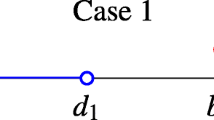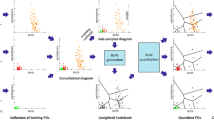Abstract
Persistence diagrams have been widely recognized as a compact descriptor for characterizing multiscale topological features in data. When many datasets are available, statistical features embedded in those persistence diagrams can be extracted by applying machine learnings. In particular, the ability for explicitly analyzing the inverse in the original data space from those statistical features of persistence diagrams is significantly important for practical applications. In this paper, we propose a unified method for the inverse analysis by combining linear machine learning models with persistence images. The method is applied to point clouds and cubical sets, showing the ability of the statistical inverse analysis and its advantages.



















Similar content being viewed by others
Explore related subjects
Discover the latest articles and news from researchers in related subjects, suggested using machine learning.Notes
A topological space X with \(\tilde{H}_{q}(X)=0\) for any q is called acyclic, where \(\tilde{H}_q(X)\) is the reduced homology of X.
A multiset is a set with multiplicity of each point.
In Robins et al. (2016), the birth/death positions are called critical points.
CGAL: https://www.cgal.org/ (Da. et al. 2017).
Scikit-learn: http://scikit-learn.org/ (Pedregosa et al. 2011).
DIPHA: A Distributed Persistent Homology Algorithm (Bauer et al. 2014).
SciPy: Open Source Scientific Tools for Python, 2001-, http://www.scipy.org/ (Jones et al. 2011–).
In the paper (Kimura et al. 2017), images in the final stage are also used. In this paper, we only use early and intermediate stage images to focus on the initial changes in the reaction.
References
Adams, H., Chepushtanova, S., Emerson, T., Hanson, E., Kirby, M., Motta, F., Neville, R., Peterson, C., Shipman, P., Ziegelmeier, L.: Persistence images: a stable vector representation of persistent homology. J. Mach. Learn. Res. 18(8), 1–35 (2017)
Bauer, U., Kerber, M., Reininghaus, J.: Distributed computation of persistent homology. Proceedings of the Sixteenth Workshop on Algorithm Engineering and Experiments (ALENEX) (2014)
Bauer, U., Kerber, M., Reininghaus, J., Wagner, H.: Phat—persistent homology algorithms toolbox. J. Symb. Comput. 78, 76–90 (2017)
Bingham, N.H., Fry, J.M.: Regression—Linear Models in Statistics. Springer, Berlin (2010)
Bishop, C.M.: Pattern Recognition and Machine Learning (Information Science and Statistics). Springer, Berlin (2007)
Bubenik, P.: Statistical topological data analysis using persistence landscapes. J. Mach. Learn. Res. 16(1), 77–102 (2015)
Buchet, M., Hiraoka, Y., Obayashi, I.: Persistent homology and materials informatics. In: Tanaka, I. (ed.) Nanoinformatics, pp. 75–95. Springer, Berlin (2018)
Carlsson, G.: Topology and data. Bull. Am. Math. Soc. 46, 255–308 (2009)
Chazal, F., Glisse, M., Labruére, C., Michel, B.: Convergence rates for persistence diagram estimation in topological data analysis. J. Mach. Learn. Res. 16, 3603–3635 (2015)
Chan, J.M., Carlsson, G., Rabadan, R.: Topology of viral evolution. PNAS 110(46), 18566–18571 (2013)
Cohen-Steiner, D., Edelsbrunner, H., Harer, J.: Stability of persistence diagrams. Discret. Comput. Geom. 37(1), 103–120 (2007)
Csurka, G., Bray, C., Dance, C. Fan, L.: Visual categorization with bags of keypoints. In: Proceeding of ECCV Workshop on Statistical Learning in Computer Vision, pp. 59–74 (2004)
Da, T.K.F., Loriot, S., Yvinec, M.: 3D Alpha Shapes. CGAL User and Reference Manual 4.11, CGAL Editorial Board (2017)
Delgado-Friedrichs, O., Robins, V., Sheppard, A.: Morse theory and persistent homology for topological analysis of 3D images of complex materials. In: 2014 IEEE International Conference on Image Processing (ICIP), pp. 4872–4876 (2014)
Delgado-Friedrichs, O., Robins, V., Sheppard, A.: Skeletonization and partitioning of digital images using discrete Morse theory. IEEE Trans. Pattern Anal. Mach. Intell. 37(3), 654–666 (2015)
de Silva, V., Ghrist, R.: Coverage in sensor networks via persistent homology. Algebraic Geom. Topol. 7, 339–358 (2007)
Dey, T.K., Hirani, A.N., Krishnamoorthy, B.: Optimal homologous cycles, total unimodularity and linear programming. SIAM J. Comput. 40(4), 1026–1044 (2011)
Edelsbrunner, H., Letscher, D., Zomorodian, A.: Topological persistence and simplification. Discret. Comput. Geom. 28(4), 511–533 (2002)
Edelsbrunner, H., Harer, J.: Computational Topology: An Introduction. AMS, Providence (2010)
Escolar, E.G., Hiraoka, Y.: Optimal cycles for persistent homology via linear programming. Optimization in the Real World Toward Solving Real-World Optimization Problems, pp. 79–96. Springer Japan, Osaka (2016)
Fasy, B.T., Lecci, F., Rinaldo, A., Wasserman, L., Balakrishnan, S., Singh, A.: Confidence sets for persistence diagrams. Ann. Stat. 42(6), 2301–2339 (2014)
Hiraoka, Y., Nakamura, T., Hirata, A., Escolar, E.G., Matsue, K., Nishiura, Y.: Hierarchical structures of amorphous solids characterized by persistent homology. Proc. Nat. Acad. Sci. USA 113, 7035–7040 (2016)
Ichinomiya, T., Obayashi, I., Hiraoka, Y.: Persistent homology analysis of craze formation. Phys. Rev. E 95(1), 012504 (2017)
Jones, E., Oliphant, T., Peterson, .P, et al.: SciPy: Open source scientific tools for Python. http://www.scipy.org/ (2001–) [Online; accessed 2018-01-20]
Kaczynski, T., Mischaikow, K., Mrozek, M.: Computational Homology. Springer, Berlin (2004)
Kimura, M., Obayashi, I., Takeuchi, Y., Hiraoka, Y.: Finding trigger sites in heterogeneous reactions using persistent-homology without preliminary material scientific information. Sci. Rep. 8, 3553 (2018)
Kusano, G., Fukumizu, K., Hiraoka, Y.: Persistence weighted Gaussian kernel for topological data analysis. Proceedings of the 33rd International Conference on Machine Learning, JMLR: W&CP 48. 2004-2013 (2016)
Kusano, G., Fukumizu, K., Hiraoka, Y.: Kernel method for persistence diagrams via kernel embedding and weight factor. Accepted in Journal of Machine Learning Research
Lowe, D.G.: Object recognition from local scale invariant features. In: Proc. of IEEE International Conference on Computer Vision, pp. 1150–1157 (1999)
Nowak, E., Jurie, F., Triggs, B.: Sampling Strategies for Bag-of-Features Image Classification. In: Computer Vision – ECCV 2006: 9th European Conference on Computer Vision, Graz, Austria, May 7-13, 2006, Proceedings, Part IV, pp. 490–503 (2006)
Otter, N., Porter, M.A., Tillmann, U., Grindrod, P., Harrington, H.A.: A roadmap for the computation of persistent homology. arXiv:1506.08903
Pearson, D.A., Bradley, R.M., Motta, F.C., Shipman, P.D.: Producing nanodot arrays with improved hexagonal order by patterning surfaces before ion sputtering. Phys. Rev. E 92(6), 062401 (2015)
Pedregosa, F., Varoquaux, G., Gramfort, A., Michel, V., Thirion, B., Grisel, O., Blondel, M., Prettenhofer, P., Weiss, R., Dubourg, V., Erplas, J., Passos, A., Cournapeau, D., Brucher, M., Perrot, M., Duchesnay, E.: Scikit-learn: Machine learning in Python. J. Mach. Learn. Res. 12, 2825–2830 (2011)
Rajan, K.: Materials informatics. Mater. Today 8(10), 38–45 (2005)
Rajan, K.: Materials informatics. Mater. Today 15(11), 470 (2012)
Reininghaus, J., Huber, S., Bauer, U., Kwitt, R.: A Stable Multi-Scale Kernel for Topological Machine Learning. 2015 IEEE Conference on Computer Vision and Pattern Recognition, 4741–4748 (2015)
Robert, T.: Regression shrinkage and selection via the lasso. J. R. Stat. Soc. Ser. B (Methodol.) 58(1), 267–288 (1996)
Robins, V., Turner, K.: Principal component analysis of persistent homology rank functions with case studies of spatial point patterns, sphere packing and colloids. Phys. D 334, 99–117 (2016)
Robins, V., Saadatfar, M., Delgado-Friedrichs, O., Sheppard, A.P.: Percolating length scales from topological persistence analysis of micro-CT images of porous materials. Water Resour. Res. 52(1), 315–329 (2016)
Saadatfar, M., Takeuchi, H., Francois, N., Robins, V., Hiraoka, Y.: Pore configuration landscape of granular crystallisation. Nat. Commun. 8, 15082 (2017). https://doi.org/10.1038/ncomms15082
Sivic, J. and Zisserman, A.: Video Google: A Text Retrieval Approach to Object Matching in Videos. In: Proc. of IEEE International Conference on Computer Vision, pp.1470–1477 (2003)
Turner, K., Mileyko, Y., Mukherjee, S., Harer, J.: Fréchet means for distributions of persistence diagrams. Discret. Comput. Geom. 52(1), 44–70 (2014)
Zomorodian, A., Carlsson, G.: Computing persistent homology. Discret. Comput. Geom. 33(2), 249–274 (2005)
Author information
Authors and Affiliations
Corresponding author
Ethics declarations
Conflict of interest
On behalf of all authors, the corresponding author states that there is no conflict of interest.
Additional information
This work is partially supported by JSPS KAKENHI Grant Number JP 16K17638, JST CREST Mathematics15656429, JST “Materials research by Information Integration” Initiative (MI2I) project of the Support Program for Starting Up Innovation Hub, Structural Materials for Innovation Strategic Innovation Promotion Program D72 and D66, and New Energy and Industrial Technology Development Organization (NEDO).
A Algorithm for generating random images
A Algorithm for generating random images
The algorithm for generating random binary images is given by Algorithm 2. It consists of six parameters, \(W, N, S\in \mathbb {N}, \sigma _1> 0, \sigma _2 > 0\), and \(t >0\). The area of white pixels in the generated image is given by the orbits of the Brownian motion of N particles on a flat torus with the size \(W \times W\). The parameters S and \(\sigma _1\) determine the length of each orbit and \(\sigma _2\) and t determine the radii of particles. In this paper we fix \(W=300\), \(\sigma _1 = 4\), \(\sigma _2 = 2\), \(t = 0.01\), and only N and S are changed. When N and S become larger, the generated image tend to have more white pixels.
These kinds of random images are frequently obtained by experimental measurements in materials science such as X-CT and TEM (Kimura et al. 2017). These seemingly disordered images are supposed to be utilized for materials informatics, and one of the motivations of this paper is to develop a universal framework for this purpose.

Rights and permissions
About this article
Cite this article
Obayashi, I., Hiraoka, Y. & Kimura, M. Persistence diagrams with linear machine learning models. J Appl. and Comput. Topology 1, 421–449 (2018). https://doi.org/10.1007/s41468-018-0013-5
Received:
Accepted:
Published:
Issue Date:
DOI: https://doi.org/10.1007/s41468-018-0013-5




